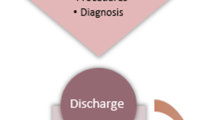Abstract
Background
Health information has a major role in the planning of future healthcare provision. With current reconfiguration and cost saving measures, further demands are being placed on acute hospitals.
Aim
To examine the elderly admissions and the referral documentation of older patients admitted to a tertiary level hospital.
Methods
A retrospective analysis of primary care referral documentation for all acute admissions of patients over 75 years to University Hospital Limerick (UHL) over a 2-month period. Documentation was analysed on the basis of patient demographics, presenting complaint and referral source. Primary care referral documentation was then analysed on the basis of presenting complaint, patient demographics, referrer details, and the clinical information provided.
Results
Over the 2-month period there were a total of 381 elderly admissions through the Emergency department. The most common presenting complaint was with shortness of breath (21.5 %). 42.5 % of admissions were from a primary care setting. 31.1 % of referrals were typed and 47.0 % handwritten. Over 90 % of referrals contained the patient’s name, date of birth and address. 98.7 % of referrals included a presenting complaint and 54 % included a past medical history. 20 % of referrals listed known drug allergies, while 9.3 % documented social history or baseline functional status. Referral letters from general practice and after-hour services were largely similar.
Conclusions
Almost all primary care referrals included the required details as per recent HIQA guidelines. The further inclusion of optional information relating to patient social or functional status, which are of particular relevance to the older population may help patient management.
Similar content being viewed by others
References
Health Information and Quality Authority (HIQA) (2011) Report and recommendations on patient referrals from general practice to outpatient and radiology services, including the national standard for patient referral information. http://www.icgp.ie/go/archive/B6BDE8D9-19B9-E185-83B9243D891B8039.html. Accessed 10th May 2015
Ong SP, Lim LT, Barnsley L, Read R (2006) General practitioners’ referral letters–do they meet the expectations of gastroenterologists and rheumatologists? Aust Fam Physician 35(11):920–922
Carney SL (2006) Medication accuracy and general practitioner referral letters. Intern Med J 36(2):132–134
General Practice Information Technology Group (GPIT) (2012) ICGP guidance document for GPs on national referral form to secondary care. http://www.icgp.ie/referral. Accessed 10th May 2015
Jiwa M, Dhaliwal S (2012) Referral Writer: preliminary evidence for the value of comprehensive referral letters. Qual Prim Care 20(1):39–45
Toleman J, Barras M. (2005) GP referral letters: are we getting the full picture? Proceedings of the Society of Hospital Pharmacists of Australia 27th Federal Conference 2005:239
Jenkins S, Arroll B, Hawken S, Nicholson R (1997) Referral letters: are form letters better? Br J Gen Pract 47(415):107–108
Grol R, Rooijackers-Lemmers N, van Kaathoven L, Wollersheim H, Mokkink H (2003) Communication at the interface: do better referral letters produce better consultant replies? Br J Gen Pract 53(488):217–219
Sorensen HT, Rasmussen HH, Mortensen FV, Freund KS. (1990) Referral to a department of medical gastroenterology. A study of the content of the referral letter and the reasons for referral. Ugeskrift laeger 152(5):322–323
Moselhy HF, Salem MO (2009) Referrals to psychiatric service in United Arab Emirates: an analysis of the content of referral letters. Int J Health Sci 3(1):8–13
Campbell B, Vanslembroek K, Whitehead E, van de Wauwer C, Eifell R, Wyatt M et al (2004) Views of doctors on clinical correspondence: questionnaire survey and audit of content of letters. BMJ (Clinical research) 328(7447):1060–1061
Bekkelund SI, Albretsen C (2002) Evaluation of referrals from general practice to a neurological department. Fam Pract 19(3):297–299
Culshaw D, Clafferty R, Brown K (2008) Let’s get physical! A study of general practitioner’s referral letters to general adult psychiatry–are physical examination and investigation results included? Scottish Med J 53(1):7–8
Pereira L, Choquet C, Perozziello A, Wargon M, Juillien G, Colosi L (2015) Unscheduled-Return-Visits after an Emergency Department (ED) Attendance and clinical link between both visits in patients aged 75 years and over: a prospective observational study. PLoS One 10(4):e0123803
Jiwa M, Dadich A (2013) Referral letter content: can it affect patient outcomes? Brit J Healthcare Man 19(3):140–146
Stiell A, Forster AJ, Stiell IG, van Walraven C (2003) Prevalence of information gaps in the emergency department and the effect on patient outcomes. CMAJ 169(10):1023–1028
Korosec L, Balenko K, Hagens S (2015) Impact of information technology on information gaps in Canadian ambulatory care encounters. JMIR Med Inform 3(1):e1. doi:10.2196/medinform.4066
Garåsen H, Johnsen R (2007) The quality of communication about older patients between hospital physicians and general practitioners: a panel study assessment. BMC Health Serv Res 24(7):133–138
Jencks SF, Williams MV, Coleman EA (2009) Rehospitalizations among patients in the medicare fee-for-service program. N Engl J Med 360(14):1418–1428
Picker D, Heard K, Bailey TC, Martin NR, LaRossa GN, Koller MH (2015) The number of discharge medications predicts thirty-day hospital readmission: a cohort study. BMC Health Serv Res. doi:10.1186/s12913-015-0950-9
Bell CM, Schnipper JL, Auerbach AD, Kaboli PJ, Wetterneck TB, Gonzales DV (2009) Association of communication between hospital-based physicians and primary care providers with patient outcomes. J Gen Intern Med 24(3):381–386
Author information
Authors and Affiliations
Corresponding author
Ethics declarations
Financial support
This research received no specific grant from any funding agency, commercial or not-for-profit sectors.
Conflict of interest
The authors declare that they have no competing interests.
Ethical approval
All procedures performed in studies involving human participants were in accordance with the ethical standards of the local institutional committee and with the 1964 Helsinki declaration and its later amendments or comparable ethical standards. As this study was retrospective in nature formal consent was not required.
Rights and permissions
About this article
Cite this article
Scully, P., O’Donnell, B., Peters, C. et al. Older patient hospital admissions following primary care referral: the truth is in the referring. Ir J Med Sci 185, 483–491 (2016). https://doi.org/10.1007/s11845-016-1404-z
Received:
Accepted:
Published:
Issue Date:
DOI: https://doi.org/10.1007/s11845-016-1404-z




